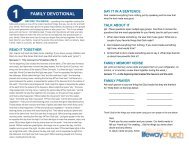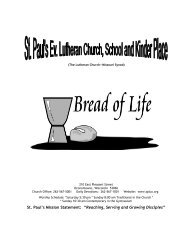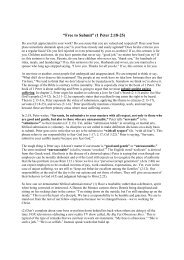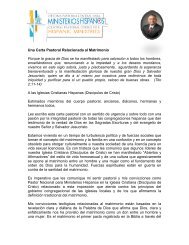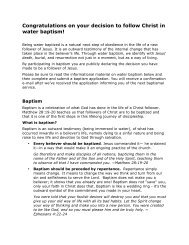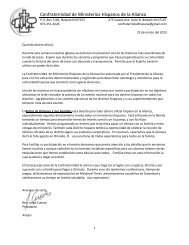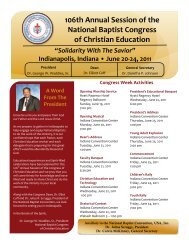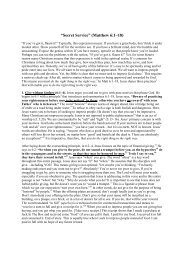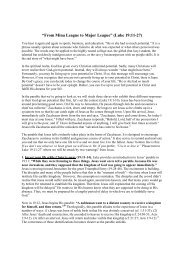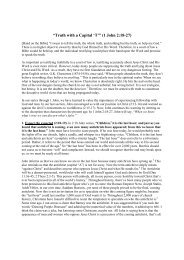A Proposal to Reduce Unnecessary Divorce - Razorplanet
A Proposal to Reduce Unnecessary Divorce - Razorplanet
A Proposal to Reduce Unnecessary Divorce - Razorplanet
You also want an ePaper? Increase the reach of your titles
YUMPU automatically turns print PDFs into web optimized ePapers that Google loves.
not, they believed. Rather than rely on expert opinion on either side of the question,<br />
Doherty, Willoughby, and Peterson decided <strong>to</strong> conduct empirical research <strong>to</strong> learn<br />
about divorcing couples’ hopes for their marriages.<br />
16. Doherty, Willoughby, and Peterson, “Interest in Marital Reconciliation.”<br />
17. These findings were consistent across most demographic and marital his<strong>to</strong>ry<br />
fac<strong>to</strong>rs.<br />
18. Furthermore, the results provide evidence that the original finding of the degree<br />
of openness <strong>to</strong> alternatives <strong>to</strong> divorce was not dependent on the wording of the<br />
questions in the survey. It is possible that the study’s results were inflated by the fact<br />
that the parents had just completed a course in parenting through divorce. Perhaps<br />
they were especially attuned <strong>to</strong> the problems their children faced and more likely <strong>to</strong><br />
express ambivalence about the divorce. However, similar results have emerged from<br />
surveys mailed <strong>to</strong> newly filing couples, most of whom had not yet taken a parenting<br />
class.<br />
19. A limitation of Professor Doherty and his colleagues’ research is that it was a<br />
survey of interest in reconciliation at one point in time without any information about<br />
whether these couples could actually succeed in res<strong>to</strong>ring their marriages <strong>to</strong> health.<br />
In fact, outside of clinical treatment studies and demographic studies of couples who<br />
separate, there has been little research on what happens <strong>to</strong> couples whose marriages<br />
are in trouble but decide <strong>to</strong> stay <strong>to</strong>gether. While there has been a lot of research on<br />
unhappy couples who go on <strong>to</strong> divorce, and some research on unhappy couples who<br />
stay <strong>to</strong>gether unhappily, there has been a gap in research on “marital turnarounds”—<br />
in other words, couples who were once unhappy and then become happy again.<br />
20. The contact person for the Family Law Marital Reconciliation Option Project is<br />
at<strong>to</strong>rney Louise Livesay (louise@livesaylawoffice.com).<br />
21. Jared R. Anderson, Mark J. Van Ryzin, and William J. Doherty, “Developmental<br />
Trajec<strong>to</strong>ries of Marital Happiness in Continuously Married Individuals: A Group Modeling<br />
Approach,” Journal of Family Psychology 24, no. 5 (Oc<strong>to</strong>ber 2010): 587–96.<br />
22. Interestingly, this turnaround was confined <strong>to</strong> people who had earlier experienced<br />
a happy marriage; thus the turnaround can be seen as a recovery. For individuals<br />
who started with low levels of marital happiness, the chances of a turnaround<br />
were more limited. The researchers speculated that the experience of having had a<br />
happy marriage at an earlier point may create a shared goal during <strong>to</strong>ugh times. In<br />
contrast, couples whose marriages are initially not happy may be less able <strong>to</strong> envision<br />
being happy <strong>to</strong>gether, or they may simply lack the skills <strong>to</strong> negotiate the emotional<br />
challenges of marriage.<br />
23. Colin Camerer et al., “Regulation for Conservatives: Behavioral Economics and<br />
the Case for ‘Asymmetrical Paternalism,’” University of Pennsylvania Law Review 151,<br />
no. 3 (January 2003): 1211–54.<br />
53



